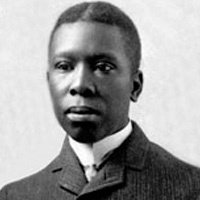Sympathy by Paul Laurence Dunbar: Summary and Analysis
Paul Laurence Dunbar through this lyric poem highlight the suffering of the oppressed by prejudice and unfair laws with the use of the analogy of caged bird. This poem is written in three stanzas containing seven lines each.

Paul L. Dunbar (1872-1906)
The first stanza opens with the thematic refrain: ‘I know what the caged bird feels’. When the sun shines in the early morning when the first bird opens, the first bird sings, the river flows in its own way and all the natural things take the natural track, the caged bird feels deprived. It feels sorry for not having the freedom of others and this feeling leads him to the protest.
The second stanza deals with the theme of protest using the thematic refrain, ‘I know why the caged bird beats his wings.’ Feeling of constraints leads the bird to protest but that protest does not give anything except the wound. He beats until the bar is red with blood; his wound becomes a scar, but he does not get the freedom. As a result he moves to the act of singing for freedom. The third stanza, which deals with the prayer of the bird comes a thematic refrain, ‘I know why the caged bird sings.’ When the protest does not give him anything, he starts making a prayer which he sends towards the heaven. Through this prayer, he is making a plea for freedom. Protest fails and Dunbar supports the prayer.
It is at this point comes a difference between Dunbar and other modern post-modern black poets. When Dunbar goes for prayer, supplication, modern and post-modern black poets go to protest. In the postmodern poetry, blacks use the themes of protest whereas in Dunbar we find the tone of supplication.
Throughout the poem, the poet is comparing himself and the African American with the caged bird who is deprived of all the natural and fundamental rights. The use of the refrain such as ‘I know what the caged bird feels’, ‘I know why the caged bird beats his wings’ and ‘I know why the caged bird sings’ in the beginning of the stanza and then at the end of the stanza further intensify the feeling of the poet as the imprisoned being even in the normal life. The feeling of suffocation is increased when the bird tries to fly but unfortunately is wounded by the bars of the cage. When the trapped bird finally starts signing as the form of prayer and a plea, we feel the sense of defeat, but not the hopelessness. The bird has still the hope of rays even though it is the slightest. It is singing and trying to forget the entrapped situation for the time being.
The poem centers round the theme of lack of freedom, especially when you are given wings and feathers to fly, but not the sky. The bird is naturally a free flying creature, but it is captivated in the cage in the context of the poem. For the sake of freedom, it bleeds, gets wounded and scars, but all its attempts are fruitless. Finally it starts praying the god in the form of song for the freedom. The bird wants to breathe the fresh air of the jungle and wants to bathe in the cooling water of the stream. The caged bird is metaphorically standing for the slaves and oppressed people of the America.
